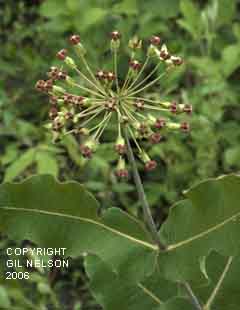Difference between revisions of "Asclepias amplexicaulis"
| Line 39: | Line 39: | ||
It flowers from spring to summer (Wunderlin and Hansen 2011). In Florida, it has been observed flowering in April and May, specifically (FSU Herbarium). Fruiting has been observed in June and July (FSU Herbarium). | It flowers from spring to summer (Wunderlin and Hansen 2011). In Florida, it has been observed flowering in April and May, specifically (FSU Herbarium). Fruiting has been observed in June and July (FSU Herbarium). | ||
| − | <ref>[[KMR|Robertson, Kevin M.]] | + | Kevin Robertson has observed this species flower within three months of burning.<ref>[[KMR|Robertson, Kevin M.]]</ref> |
===Seed dispersal=== | ===Seed dispersal=== | ||
Revision as of 17:08, 9 February 2016
| Asclepias amplexicaulis | |
|---|---|

| |
| photo by Gil Nelson | |
| Scientific classification | |
| Kingdom: | Plantae |
| Division: | Magnoliophyta - Flowering plants |
| Class: | Magnoliopsida - Dicotyledons |
| Order: | Gentianales |
| Family: | Asclepiadaceae |
| Genus: | Asclepias |
| Species: | A. amplexicaulis |
| Binomial name | |
| Asclepias amplexicaulis Sm. | |

| |
| Natural range of Asclepias amplexicaulis from USDA NRCS Plants Database. | |
Common names: Clasping Milkweed, Sand Milkweed
Contents
Taxonomic notes
Description
Weakley (2015) mentions that the aroma of the inflorescence smells of cloves and roses.
In general, with the Asclepias genus, they are perennial herbs usually milky sap. The stems are erect, spreading or decumbent and usually are simple and often solitary. The leaves are opposite to subopposite, are sometimes whorled, and rarely alternate. The corolla lobes are reflexed and are rarely erect or spreading. The filaments are elaborate into five hood forming a corona around the gynosteguim. The corona horns are present in most species. (Radford 1964).
Specifically, for Asclepias amplexicaulis, the stem are 1-3 from a root crown, simple, stout, erect, 4-10 dm tall and are glabrous. The leaves are opposite and usually in 4-6 pairs, are widely ovate to ovate-elliptic in shape, and are 8-15 cm long and 4-8 cm wide. The leaves are mucronate, crispate, auriculate-clasping, glaucous and sessile. The umbel corona is 5-8 mm in diameter. The horns are 1.5 times as long as the hood that are arching over the gynostegium. The follicles are erect, are 8-14 cm long, and are 1.2-2.3 cm broad. Flowers from May to July. (Radford 1964).
Distribution
It is found as north as New Hampshire and New York, then west to Kansas, south to Texas and Florida (Weakley 2015). In Florida, it’s found in south to central peninsula (Weakley 2015).
Ecology
Habitat
Asclepias amplexicaulis is found on the upper slopes of longleaf pine-wiregrass flatwoods, and in mixed pine-hardwood habitat, open sand pine woodlands, and longleaf pine-oak-wiregrass sandhill communities (FSU Herbarium). It prefers high light levels associated with open woodlands and dry sandy soils such as loamy sand (FSU Herbarium). It can also appear in human disturbed areas like clearings and roadsides (FSU Herbarium).
Associated species include Pinus palustris, Aristida stricta, Quercus laevis, and Baptisia lecontei (FSU Herbarium).
Phenology
It flowers from spring to summer (Wunderlin and Hansen 2011). In Florida, it has been observed flowering in April and May, specifically (FSU Herbarium). Fruiting has been observed in June and July (FSU Herbarium).
Kevin Robertson has observed this species flower within three months of burning.[1]
Seed dispersal
Seed bank and germination
Fire ecology
It is present in burned areas (FSU Herbarium).
Pollination
Use by animals
Diseases and parasites
Conservation and Management
Cultivation and restoration
Photo Gallery
References and notes
Florida State University Robert K. Godfrey Herbarium database. URL: http://herbarium.bio.fsu.edu. Last accessed: June 2014. Collectors: Loran C. Anderson, Robert K. Godfrey, Sidney McDaniel, R. A. Norris, Richard R. Clinebell II, Travis MacClendon, Karen MacClendon, and G. Wilder. States and Counties: Florida: Washington, Franklin, Leon, Okaloosa, Holmes, Wakulla, Calhoun, and Jackson. Georgia: Thomas.
Radford, Albert E., Harry E. Ahles, and C. Ritchie Bell. Manual of the Vascular Flora of the Carolinas. 1964, 1968. The University of North Carolina Press. 848-852. Print.
Weakley, Alan S. Flora of the Southern and Mid-Atlantic States: Working Draft of 21 May 2015. University of North Carolina Herbarium (NCU). PDF. 931.
Wunderlin, Richard P. and Bruce F. Hansen. Guide to the Vascular Plants of Florida. Third edition. 2011. University Press of Florida: Gainesville/Tallahassee/Tampa/Boca Raton/Pensacola/Orlando/Miami/Jacksonville/Ft. Myers. 270. Print.